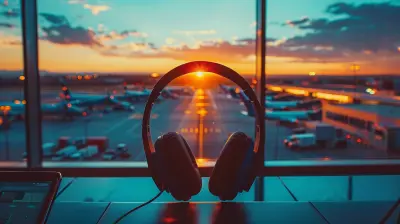How Virtual Reality is Empowering People with Disabilities
6 July 2025
We live in a world where technology is moving faster than ever—and that's pretty exciting. One innovation that’s truly making waves is Virtual Reality (VR). From gaming to education to professional training, VR’s reach is expanding rapidly. But there’s one area that doesn’t always get the spotlight it deserves: how VR is revolutionizing life for people with disabilities.
Imagine being able to walk through the Louvre Museum in Paris without ever leaving your living room. Or attending school, job interviews, or even therapy sessions—all from the comfort of your home. For many people with disabilities, VR is not just a cool gadget; it’s a tool of empowerment.
In this article, we’ll dive deep into how Virtual Reality is opening doors, shattering limitations, and giving people with disabilities the power to experience life in brand-new ways.
What Exactly Is Virtual Reality?
Alright, before we get too into the weeds, let’s hit pause and define what we’re talking about.Virtual Reality is a computer-generated simulation where you can interact with a 3D environment in a seemingly real or physical way. Typically, it involves wearing a headset with sensors and sometimes even gloves or controllers to manipulate digital objects.
In short, it’s like stepping into another world—except you never leave your room.
Why VR Matters for People with Disabilities
So why is VR such a game-changer for people with disabilities?Think about the everyday challenges someone with limited mobility, vision, or hearing might face. Simple things—like attending a concert, navigating unknown terrain, or even just socializing—can be a huge obstacle. VR has the potential to level the playing field. It can simulate these experiences in accessible ways, making life fuller, richer, and more independent.
Let’s break it down further.
Enhancing Mobility Through Virtual Environments
For individuals with mobility impairments, VR can be an absolute lifeline.Virtual Travel and Exploration
Being confined to a wheelchair—or even bedridden—doesn’t mean missing out on the world anymore. With VR, users can:- Tour landmarks like the Great Wall of China or Machu Picchu.
- Visit art galleries and museums around the globe.
- Experience nature trails, beaches, or urban cities—all from home.
This isn’t just entertainment—it’s enrichment. It’s about creating stories, memories, and connections with places people once only dreamed of seeing.
Practicing Real-Life Scenarios
Being independent is important. But for someone newly adjusting to a disability, even crossing the street can feel daunting. VR offers safe, repeatable practice environments where users can simulate interactions like:- Using public transportation.
- Navigating through complex spaces like malls or airports.
- Engaging in everyday activities like grocery shopping.
No pressure. No risk. Just immersive training that builds confidence.
Revolutionizing Education and Learning
It’s no secret that traditional classrooms can be limiting for students with disabilities. VR, on the other hand, offers customizable experiences that cater to individual needs.Personalized Learning Environments
Whether it's a student with ADHD who needs fewer distractions, or someone with a hearing impairment who benefits from visual instruction, VR can adapt.Teachers can:
- Create interactive, 3D lessons that engage multiple senses.
- Offer real-time feedback through virtual tutors.
- Simulate complex processes, like human anatomy, in ways books just can’t match.
The best part? Everyone learns at their own pace.
Social Skills Development
For students on the autism spectrum or with social anxiety, traditional social settings can be overwhelming. VR can act as a bridge. It offers safe, repeatable social scenarios that help users build skills like:- Reading body language.
- Making eye contact.
- Engaging in conversations.
These tools aren’t replacing human connection—they’re building a foundation for more of it.
Expanding Career Opportunities and Job Training
Let’s talk employment. The job market can be tough for people with disabilities—not because of lack of ability, but because of lack of access. VR is helping to flip that script.Accessible Job Training
Want to learn how to operate complex machinery but can’t get to a specialized training center? VR says, “No problem.”With immersive simulations, users can:
- Practice hands-on skills in fields like automotive repair, manufacturing, or medical diagnostics.
- Prepare for interviews in interactive, lifelike settings.
- Train in customer service through avatar interactions.
It’s realistic. It’s safe. And it’s scalable.
Working Remotely in Virtual Offices
Remote work is the new normal for many, but VR takes it one step further. Rather than staring at a flat screen, imagine logging into a virtual office:- Collaborate with team members’ avatars in real time.
- Attend meetings, brainstorm sessions, and even virtual water-cooler chats.
- Customize your virtual workspace to suit your comfort and needs.
Welcome to the future of inclusive workspaces.
Boosting Mental Health and Emotional Well-being
We can’t talk about disability without also talking about mental health. Feelings of isolation, depression, and anxiety are common. That’s where VR really shines.Virtual Therapy Sessions
Therapists now use VR for exposure therapy, relaxation training, and even role-playing scenarios. For example:- Veterans with PTSD can revisit and gradually desensitize traumatic experiences in a controlled setting.
- Individuals with phobias (like social anxiety or fear of heights) can slowly face those fears virtually.
The beauty? It’s immersive—but always under control.
Building Communities and Friendships
Platforms like VRChat or AltspaceVR allow users to meet, talk, and hang out in virtual worlds. For many people with disabilities, this can be a crucial connection to a larger world.- Make friends across the globe.
- Join support groups or interest-based communities.
- Participate in events like concerts, dances, or comedy nights.
It’s freedom, connection, and inclusion—all packaged in a headset.
Making Recreation More Inclusive
Let’s not forget about fun—because everyone deserves a good time.Adaptive Gaming
Gaming isn’t just for the able-bodied anymore. VR-based games are now being developed with:- Customizable controls for varying motor abilities.
- Audio descriptions for the visually impaired.
- Haptic feedback for sensory guidance.
Gaming in VR becomes a playground of possibilities, where winning isn’t just about points—it’s about participation.
Inclusive Fitness and Movement
Fitness tech is booming, and VR is joining the party. Think virtual yoga classes, dance sessions, or guided meditation—all adapted to suit different abilities.- Wheelchair-friendly cardio routines.
- Voice-guided VR workouts.
- Meditation walks through serene digital forests.
Staying active has never been more accessible—or more fun.
Real People, Real Impact
Let’s bring this home with a few stories.- Meet Jason – A quadriplegic artist who uses VR painting tools to create 3D masterpieces. His vibrant works have even been showcased in digital galleries.
- Maya’s Journey – A young girl with autism who found her voice through VR storytelling games, eventually leading her to write her own book.
- Luis the Adventurer – Despite multiple sclerosis, Luis “travels” the world daily, his favorite stop being a VR simulation of the Amazon rainforest.
These aren’t just anecdotes. They’re snapshots of what tech-powered inclusion looks like.
Challenges That Still Need Tackling
Okay, we’ve sung VR’s praises—but it’s not all sunshine and rainbows. There are still some bumps on the road to full accessibility.Cost Barriers
High-end VR sets can be pricey. For individuals already facing medical expenses, this tech might feel out of reach.Tech Literacy
Not everyone is comfortable with new technology. Elderly users or those with cognitive disabilities may struggle to adopt VR without proper training or support.Content Accessibility
We still need more developers creating inclusive VR experiences—not just as an afterthought, but from the ground up.The good news? Awareness is growing, and companies are paying attention.
The Road Ahead: What’s Next?
As VR hardware gets cheaper and software becomes more inclusive, we’re headed toward a future where Virtual Reality is a daily tool—not a luxury.Innovations to watch for:
- Brain-computer interfaces for hands-free VR control.
- AI-driven customization for hyper-personalized experiences.
- Open-source libraries for inclusive VR world-building.
The next decade could be transformational—not just for how we play or work—but for how we include, respect, and empower people of all abilities.
Final Thoughts
Virtual Reality isn’t just an escape from the real world; it’s a bridge to a more inclusive one. For people with disabilities, it's not about tech for tech's sake—it’s about reclaiming independence, dignity, and joy.In the end, VR is more than pixels and headsets. It’s opportunity. It’s access. It’s empowerment.
And honestly? That’s the kind of future worth plugging into.
all images in this post were generated using AI tools
Category:
Virtual RealityAuthor:

Michael Robinson
Discussion
rate this article
2 comments
Arlo Wade
This article beautifully highlights how VR opens new doors for individuals with disabilities. Inspiring progress!
October 18, 2025 at 12:12 PM

Michael Robinson
Thank you! I'm glad you found the article inspiring and reflective of the positive impact VR can have for individuals with disabilities.
Emma Maddox
Absolutely inspiring! It's amazing to see how virtual reality is breaking barriers and creating new opportunities for people with disabilities. Empowerment through technology at its best! 🎉
July 18, 2025 at 12:45 PM

Michael Robinson
Thank you! I'm glad you found it inspiring. Virtual reality truly is a game-changer for empowerment and accessibility! 🎉


